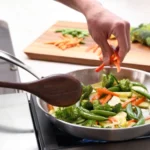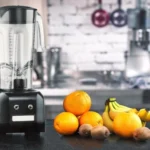How Do Knives Go Dull?

Knives do not lose their sharpness due to the foods they cut, but rather because of the cutting board they are used on. This assumes normal usage, not the more severe mistreatment many kitchen knives endure, such as being placed in the dishwasher, thrown into a drawer, or used for tasks like opening cans.
Each time a knife slices through food on a cutting board, its edge experiences wear. Initially, the blade’s edge may become misaligned; while still sharp, it can be bent slightly out of shape. This issue can typically be fixed with a few passes on a honing steel.
A more serious problem arises when, over time, repeated use on the cutting board wears down the blade’s edge so that it transitions from a V-shape to a U-shape. In such cases, reshaping the blade requires grinding away some of the metal to restore the edge to its original sharpness. This process is usually accomplished with a sharpening stone.
Sharpening a Serrated Knife

If you’re accustomed to sharpening a standard chef’s knife, you’re aware that the process involves making a series of long, even strokes on a sharpening stone, then flipping the blade and repeating the process on the opposite side.
This method works well for knives with a straight edge, but serrated knives require a different approach.
Upon closer inspection of a serrated knife’s edge, one can see that it is made up of a series of curved serrations. The blade typically has a beveled side with these serrations and a flat side.
When it comes to sharpening a serrated knife, each individual serration needs to be sharpened separately. The flat side of the blade does not require any sharpening.
To handle this task effectively, a specialized tool known as a sharpening rod is used. This tool is specifically designed to sharpen each serration individually.
How to Use a Sharpening Rod

A sharpening rod resembles a honing steel but is smaller and narrower, tapering to a point. This design allows for varying thicknesses along the rod’s length, accommodating the different widths of serrations on various knives. Sharpening rods come in materials like steel, ceramic, and even diamond, each offering unique benefits.
To use the sharpening rod, select the section that best matches the width of your knife’s serrations. Glide the rod across each serration, ensuring the rod is aligned with the bevel to maintain the correct angle. Although you can drag the rod in either direction, it’s safer to pull it away from the blade to avoid accidental cuts.
Apply four to five strokes to each serration before moving on to the next. With knives featuring 30 or more serrations, this process can be time-consuming, but it remains straightforward.
After sharpening, turn the knife over and use a regular sharpening stone or fine-grit sandpaper to smooth out any burrs on the flat side of the blade. Finally, wash and dry the knife as usual, and it will be ready for use.
Conclusion
When it comes to maintaining a sharp edge on your knives, the right tools and techniques make all the difference. Whether you’re dealing with a serrated blade or a straight-edged knife, understanding the specific sharpening needs of each type ensures your knives perform optimally. Serrated knives, with their unique tooth-like edges, require specialized sharpening methods to keep each serration in top condition, while traditional knives benefit from regular honing and grinding to maintain a sharp, precise edge.
Investing in quality sharpening tools like a sharpening rod or a honing steel can enhance the lifespan and effectiveness of your knives, making your kitchen tasks smoother and more enjoyable. Regular maintenance not only improves performance but also ensures safety by reducing the effort required to cut through various foods.
Ultimately, whether you’re a home cook or a professional chef, knowing how to properly care for your knives is essential for achieving the best results in the kitchen. By following these sharpening techniques and using the right equipment, you’ll keep your knives sharp, efficient, and ready to tackle any culinary challenge.


